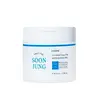What's inside
What's inside
 Key Ingredients
Key Ingredients

 Benefits
Benefits

 Ingredients Side-by-side
Ingredients Side-by-side

Water
Skin ConditioningPropanediol
SolventGlycerin
HumectantBetaine
Humectant1,2-Hexanediol
Skin ConditioningPanthenol
Skin ConditioningPolyglycerin-3
HumectantAllantoin
Skin ConditioningEthylhexylglycerin
Skin ConditioningButylene Glycol
HumectantDisodium EDTA
Carbomer
Emulsion StabilisingMadecassoside
AntioxidantCentella Asiatica Flower/Leaf/Stem Extract
Skin ConditioningCamellia Sinensis Leaf Extract
AntimicrobialArtemisia Capillaris Extract
Tocopherol
AntioxidantAcrylates/Stearyl Methacrylate Copolymer
Emulsion StabilisingTremella Fuciformis Sporocarp Extract
AntioxidantHyaluronic Acid
HumectantXanthan Gum
EmulsifyingCeramide NP
Skin ConditioningWater, Propanediol, Glycerin, Betaine, 1,2-Hexanediol, Panthenol, Polyglycerin-3, Allantoin, Ethylhexylglycerin, Butylene Glycol, Disodium EDTA, Carbomer, Madecassoside, Centella Asiatica Flower/Leaf/Stem Extract, Camellia Sinensis Leaf Extract, Artemisia Capillaris Extract, Tocopherol, Acrylates/Stearyl Methacrylate Copolymer, Tremella Fuciformis Sporocarp Extract, Hyaluronic Acid, Xanthan Gum, Ceramide NP
Water
Skin ConditioningButylene Glycol
HumectantMethylpropanediol
SolventCentella Asiatica Extract
CleansingCaprylyl Glycol
EmollientGlycerin
HumectantOctyldodeceth-16
EmulsifyingPanthenol
Skin ConditioningSodium Hyaluronate
HumectantCeramide NP
Skin ConditioningMadecassoside
AntioxidantPhospholipids
Skin ConditioningHydrogenated Lecithin
EmulsifyingCaprylic/Capric Triglyceride
MaskingSodium Polyacryloyldimethyl Taurate
Emulsion StabilisingStyrene/Vp Copolymer
Caprylhydroxamic Acid
Diethoxyethyl Succinate
SolventWater, Butylene Glycol, Methylpropanediol, Centella Asiatica Extract, Caprylyl Glycol, Glycerin, Octyldodeceth-16, Panthenol, Sodium Hyaluronate, Ceramide NP, Madecassoside, Phospholipids, Hydrogenated Lecithin, Caprylic/Capric Triglyceride, Sodium Polyacryloyldimethyl Taurate, Styrene/Vp Copolymer, Caprylhydroxamic Acid, Diethoxyethyl Succinate
 Reviews
Reviews

Ingredients Explained
These ingredients are found in both products.
Ingredients higher up in an ingredient list are typically present in a larger amount.
Butylene Glycol (or BG) is used within cosmetic products for a few different reasons:
Overall, Butylene Glycol is a safe and well-rounded ingredient that works well with other ingredients.
Though this ingredient works well with most skin types, some people with sensitive skin may experience a reaction such as allergic rashes, closed comedones, or itchiness.
Learn more about Butylene GlycolCeramide NP is a type of ceramide and formally known as ceramide 3.
Ceramides are intercellular lipids naturally found in our skin that bonds dead skin cells together to create a barrier. They are known for their ability to hold water and thus are a great ingredient for dry skin.
Ceramides are an important building block for our skin barrier. A stronger barrier helps the skin look more firm and hydrated. By bolstering the skin ceramides act as a barrier against irritating ingredients. This can help with inflammation as well.
If you would like to eat ceramides, sweet potatoes contain a small amount.
Read more about other common types of ceramides here:
Ceramide AP
Ceramide EOP
Glycerin is already naturally found in your skin. It helps moisturize and protect your skin.
A study from 2016 found glycerin to be more effective as a humectant than AHAs and hyaluronic acid.
As a humectant, it helps the skin stay hydrated by pulling moisture to your skin. The low molecular weight of glycerin allows it to pull moisture into the deeper layers of your skin.
Hydrated skin improves your skin barrier; Your skin barrier helps protect against irritants and bacteria.
Glycerin has also been found to have antimicrobial and antiviral properties. Due to these properties, glycerin is often used in wound and burn treatments.
In cosmetics, glycerin is usually derived from plants such as soybean or palm. However, it can also be sourced from animals, such as tallow or animal fat.
This ingredient is organic, colorless, odorless, and non-toxic.
Glycerin is the name for this ingredient in American English. British English uses Glycerol/Glycerine.
Learn more about GlycerinMadecassoside comes from the super popular skin-soothing ingredient, Centella asiatica. It is one of four active compounds found in the extract of Centella Asiatica.
Madecassoside has antioxidant, anti-inflammatory, and hydrating properties. It contains fatty acids, amino acids, beta-carotene, and phytochemicals.
One study found using Madecassoside with ascorbic acid helped reduce the signs of aging and improved skin hydration.
Learn more about MadecassosidePanthenol is a common ingredient that helps hydrate and soothe the skin. It is found naturally in our skin and hair.
There are two forms of panthenol: D and L.
D-panthenol is also known as dexpanthenol. Most cosmetics use dexpanthenol or a mixture of D and L-panthenol.
Panthenol is famous due to its ability to go deeper into the skin's layers. Using this ingredient has numerous pros (and no cons):
Like hyaluronic acid, panthenol is a humectant. Humectants are able to bind and hold large amounts of water to keep skin hydrated.
This ingredient works well for wound healing. It works by increasing tissue in the wound and helps close open wounds.
Once oxidized, panthenol converts to pantothenic acid. Panthothenic acid is found in all living cells.
This ingredient is also referred to as pro-vitamin B5.
Learn more about PanthenolWater. It's the most common cosmetic ingredient of all. You'll usually see it at the top of ingredient lists, meaning that it makes up the largest part of the product.
So why is it so popular? Water most often acts as a solvent - this means that it helps dissolve other ingredients into the formulation.
You'll also recognize water as that liquid we all need to stay alive. If you see this, drink a glass of water. Stay hydrated!
Learn more about Water